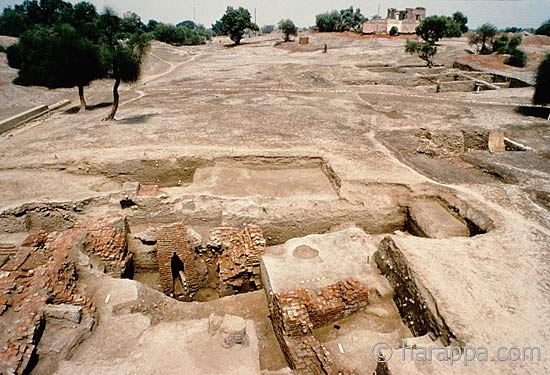The Indus Civilization (cont.)
 The urban expansion and increasing stratification of social classes in the Indus cities required the development of new forms of symbolic expression and new mechanisms for reinforcing social organization.
The urban expansion and increasing stratification of social classes in the Indus cities required the development of new forms of symbolic expression and new mechanisms for reinforcing social organization.
The use of elaborate ornaments (77 Bangles, 78 Bangles, 79 Ornaments, 80 Belt, 81 Necklace, 82 Ornaments, 83 Glazed Tiles, 84 Beads), sculpture (39 Head, 40 Head (back), 41 Priest King, 42 Priest King (back), 43 Priest King (side), 44 Sculpture, 45 Seated male (back), 46 Male) and terra cotta figurines (47 Figurines, 48 Heads, 49 Males, 50 Female, 51 Female, 52 Figurines, 53 Replicas, 54 Bull, 55 Modern bull, 56 Bull figurine, 57 Farmers, 58 Ram, 59 Sheep, 60 Dog, 61 Tiger, 62 Turtle, 63 Elephant, 64 Monkey, 65 Whistles) became widespread.
 Seals and writing (24 Moulded Tablet, 25 Unicorn Seal, 26 Unicorn Seal back, 27 Bull Seal, 28 Bison Seal, 29 Inscribed Objects, 30 Tablets, 31 Sealings, 32 Mohenjo-daro Seal, 33 Yogic Seal 34 Giant Ram Seal, 35 Seal, 36 Silver Seal, 37 Seals, 38 Tokens), decorated pottery (69 Burial Pottery, 70 Burial Pottery), and new ritual objects (85 Vessels, 86 Shell Ladle, 87 Mask, 88 Three Objects, 89 Moulded Tablet, 90 Tablet) are unifying cultural symbols of the Harappan phase.
Seals and writing (24 Moulded Tablet, 25 Unicorn Seal, 26 Unicorn Seal back, 27 Bull Seal, 28 Bison Seal, 29 Inscribed Objects, 30 Tablets, 31 Sealings, 32 Mohenjo-daro Seal, 33 Yogic Seal 34 Giant Ram Seal, 35 Seal, 36 Silver Seal, 37 Seals, 38 Tokens), decorated pottery (69 Burial Pottery, 70 Burial Pottery), and new ritual objects (85 Vessels, 86 Shell Ladle, 87 Mask, 88 Three Objects, 89 Moulded Tablet, 90 Tablet) are unifying cultural symbols of the Harappan phase.

Although there is a general unity in style and symbol over this vast area, there are specific regional styles. The manufacture of symbols is also slightly different for each region.

The unified character of this culture continued for almost 700 years, after which there is evidence for a gradual trend towards regionalization.
 Through the processes of over expansion and changes in important river patterns, the Harappan urban centers began to decline around 1900 B.C., and the unifying cultural symbols of the cities were no longer useful.
Through the processes of over expansion and changes in important river patterns, the Harappan urban centers began to decline around 1900 B.C., and the unifying cultural symbols of the cities were no longer useful.

However, the regional cultures that began to take form did retain some of the characteristic symbols and technologies of the Harappan culture.
These continuities provide an important thread connecting the developments of the first urban civilization to later cultures that became dominant in the regions of northern Pakistan and India.
 Some of the technologies, architecture, artistic symbols and aspects of social organization that characterized the first urban centers of the Indus Civilization have continued up to the present in the urban setting of traditional South Asian cities.
Some of the technologies, architecture, artistic symbols and aspects of social organization that characterized the first urban centers of the Indus Civilization have continued up to the present in the urban setting of traditional South Asian cities.
